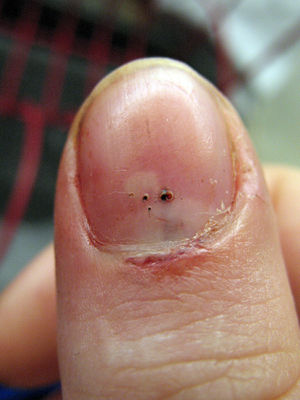We need you! Join our contributor community and become a WikEM editor through our open and transparent promotion process.
Subungual hematoma
From WikEM
(Redirected from Subungal Hematoma)
Contents
Background
Subungual hematoma is a collection of blood under the nail and and the nail bed. There is a strong association with distal phalanx fractures. In the past, complete nail removal and exploration and closure of possible nail bed lacerations was performed. A prospective study of 52 children supports management with trephination alone for any size hematoma.[1]
Types
- Simple - no nailbed dislocation, no evidence of an open fracture
- Complex - associated with a fracture or a nail plate disruption
Clinical Features
- Blood trapped under nail
Differential Diagnosis
- Subungual hematoma
- Distal Phalanx (Finger) Fracture
- Nailbed laceration
Hand and finger injuries
- Radiograph positive
- Radiograph negative
- Dupeytren contracture
- Boutonniere deformity
- Hand and finger tendon injuries
- Ganglion cyst
- De Quervain tenosynovitis
- Intersection syndrome
- Drummer's wrist
- Extensor digitorum tenosynovitis
- Vaughn Jackson syndrome
- Snapping Extensor Carpi Ulnaris
- Compressive neuropathy, "bracelet syndrome"
- Scaphoid fracture
- Osteoarthritis
- Infiltrative tenosynovitis
- Gout
- Rheumatoid arthritis
- Trigger finger
- Mallet finger
- Jersey finger
- Jammed finger
- Subungual hematoma
- Fingertip laceration
- Metacarpophalangeal (MCP) ulnar ligament rupture (Gamekeeper's thumb)
- Nail avulsion
- High-pressure injection injury
Evaluation
- Clinical diagnosis
- Evaluate percentage of nail bed involved, test extensor/flexor tendons, distal cap refill
Management
Simple
- Trephination
- Cleanse with povidone-iodine solution (not flammable alcohol)
- Handheld cautery works best - no anesthesia is required
- Alternatively a needle spun in a drilling fashion
- Sharp object (i.e. safety pin) heated with flame in an austere environment
- If a fracture is present, the digit should be splinted
- Instruct patients to soak affected finger in warm water BID-TID x7d
- Prophylactic antibiotics are not needed after trephination of uncomplicated hematomas [2]
Complex
- Nail removal only recommended if there is associated nail avulsion or nail fold disruption[3]
- Repair nailbed laceration using absorbable sutures
Disposition
- Outpatient
See Also
References
- ↑ Roser SE, Gellman H. Comparison of nail bed repair versus nail trephination for subungual hematomas in children. J Hand Surg. 1999;24(6):2266-1170.
- ↑ Holtzman L. Incision and Drainage. In: Roberts and Hedges' Clinical Procedures in Emergency Medicine. 6th ed. Philadelphia, PA: Elsevier; 2014.
- ↑ Seaberg DC, ANgelos WJ, et al. Treatment of subungual hematomas with nail trephination: a prospective study. Am J Emerg Med. 1991; 9(3):209-210


